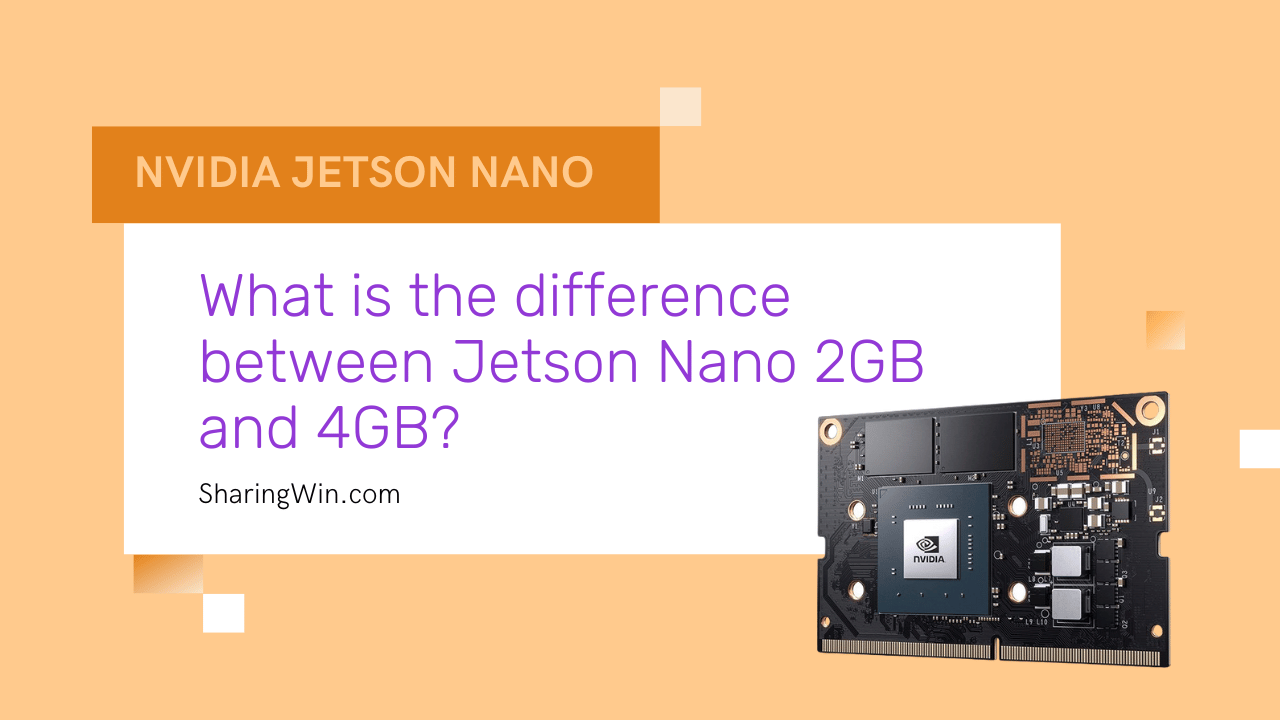NVIDIA’s Jetson Nano series is a robust solution tailored for edge computing and AI applications. Among the models available, the Jetson Nano 2GB and Jetson Nano 4GB are two popular options. Although they share the same underlying computational platform, there are significant differences in memory, features, and target users, making them suitable for different applications. This article offers a detailed comparison to assist you in choosing the right development board for your needs.

Core Specification Comparison
| Feature | Jetson Nano 2GB | Jetson Nano 4GB |
| Memory | 2GB LPDDR4 | 4GB LPDDR4 |
| CPU | Quad-core ARM Cortex-A57 | |
| GPU | 128-core Maxwell GPU | |
| Compute Power | 472 GFLOPS | |
| Storage Interface | microSD card slot | |
| Camera Support | USB camera | MIPI CSI and USB camera support |
| Power Interface | Micro-USB | Barrel Jack and Micro-USB |
Memory Capacity: Key Performance Difference
Jetson Nano 2GB: Equipped with 2GB LPDDR4 memory, ideal for lightweight AI models and basic tasks such as voice recognition or simple image classification.
Jetson Nano 4GB: With 4GB LPDDR4 memory, it can handle more complex tasks like running larger deep learning models, video stream processing, or multitasking.
For instance, when loading a pre-trained YOLOv4 model, the 4GB version can run more efficiently, while the 2GB version might face memory constraints and performance bottlenecks.
Camera Interface and Machine Vision
Jetson Nano 2GB: Supports only USB cameras, which limits its performance for high-frame-rate or multi-camera machine vision projects.
Jetson Nano 4GB: In addition to USB cameras, it supports the MIPI CSI interface, a high-performance camera connection widely used in robotics and drone applications.
If your project involves machine vision tasks like object detection or real-time tracking, the 4GB model offers greater flexibility and scalability.
Power Requirements
Jetson Nano 2GB: Powered via Micro-USB, suitable for simpler projects with lower power demands.
Jetson Nano 4GB: Supports Barrel Jack power input, ensuring stable power delivery for higher-performance projects, such as industrial-grade applications running for extended periods.
When working with power-hungry peripherals like multiple sensors or cameras, the 4GB model provides greater reliability.
Target Users and Application Scenarios
Jetson Nano 2GB:
Target Users: AI beginners, educators, and budget-conscious developers.
Use Cases:
Basic AI learning and experiments.
Prototyping for robotics projects.
Low-power edge computing applications.
Jetson Nano 4GB:
Target Users: Intermediate to advanced developers or users with higher performance needs.
Use Cases:
High-performance machine vision and real-time video analysis.
Deep learning inference (e.g., YOLO, TensorFlow).
Industrial edge computing and smart IoT devices.
User Experience
Jetson Nano 2GB: Provides a simplified feature set for quick onboarding but may encounter memory limitations for complex projects.
Jetson Nano 4GB: Capable of supporting more demanding development tasks while maintaining better stability and performance.
Buying Recommendations
Choose Jetson Nano 2GB if:
You are a beginner aiming to learn the basics of AI and edge computing.
You have a tight budget and want low-cost AI development experience.
Your project doesn’t require high performance, such as basic robotics or simple IoT applications.
Choose Jetson Nano 4GB if:
You are an intermediate or advanced developer needing to run complex AI models.
Your project involves machine vision, large-scale data processing, or multitasking.
You require stable power delivery and better camera compatibility.
FAQs
Q1: What’s the difference between 2GB LPDDR4 memory and 4GB LPDDR4 memory?
A1:
Here’s a detailed comparison between 2GB LPDDR4 and 4GB LPDDR4 memory:
| Feature | 2GB LPDDR4 | 4GB LPDDR4 |
| Memory Capacity | 2GB | 4GB |
| Primary Use | Basic tasks, lightweight OS, embedded devices | Multitasking, high-performance applications, full desktop OS |
| Performance | Suitable for single or lightweight tasks | Better multitasking, supports complex applications |
| Multitasking | Limited, may face memory bottlenecks | Handles multiple tasks smoothly |
| Supported OS | Lightweight OS (e.g., Linux Lite, RTOS) | Full OS (e.g., Ubuntu, Windows 10 IoT) |
| Application Scenarios | Smart home, sensor modules, lightweight development boards | Edge computing, dev boards, machine learning, desktop use |
| Cost | Lower | Higher |
| Power Consumption | Lower, ideal for low-power devices | Slightly higher, but still efficient |
| Data Throughput | Limited for large datasets | Higher throughput for data-heavy tasks |
| Future Scalability | Limited | More flexible for future complex applications |
Smoothness: 4GB memory prevents performance drops caused by insufficient memory, especially in multitasking or data-heavy applications.
Processing Power: 4GB is more suitable for tasks requiring higher resource utilization, such as training machine learning models or running image processing algorithms.
Future Requirements: If your application might grow in complexity, 4GB is a more future-proof option.
Q2: What is Jetson Nano used for?
A2:
The NVIDIA Jetson Nano is a compact, powerful AI development board designed for running machine learning, computer vision, and AI applications at the edge. It is widely used in robotics, IoT, drones, and embedded systems due to its ability to perform real-time processing of video streams, object detection, and natural language processing. Featuring a quad-core ARM Cortex-A57 CPU, 128 CUDA-core GPU, and support for frameworks like TensorFlow and PyTorch, it enables developers to prototype and deploy AI models efficiently in energy-efficient environments.
Q3: Is Jetson Nano faster than Raspberry Pi?
A3:
| Feature | Jetson Nano | Raspberry Pi 4 |
| CPU | Quad-core ARM Cortex-A57 (1.43 GHz) | Quad-core ARM Cortex-A72 (1.5 GHz) |
| GPU | 128-core NVIDIA Maxwell GPU | VideoCore VI GPU (general-purpose) |
| AI Performance | Optimized for AI tasks (TensorFlow, PyTorch) | Limited AI support, CPU-bound |
| Memory Options | 4GB LPDDR4 | 2GB/4GB/8GB LPDDR4 |
| Power Consumption | 5-10W | 3-5W |
| Strengths | Superior for AI, computer vision, machine learning | Great for general-purpose computing, IoT |
Q4: What happened to Jetson Nano?
A4:
The Jetson Nano remains an active product in NVIDIA’s lineup and is widely used for edge AI and embedded applications. However, in recent years, NVIDIA has introduced newer and more powerful models, such as the Jetson Xavier NX and Jetson Orin. These models offer significantly higher performance for AI and robotics tasks, featuring improved CPU and GPU capabilities, additional memory options, and enhanced capacity to manage demanding workloads.
Despite recent advancements in technology, the Jetson Nano remains a popular choice for entry-level AI development, prototyping, and cost-effective solutions. It continues to serve as an important platform for developers and hobbyists looking for an affordable yet powerful option for machine learning, computer vision, and edge robotics. Although it may not offer the latest specifications in terms of raw power, it is still widely used and well-supported across various applications.
